Abstract
Artificial light at night (ALAN) is one of the fastest growing anthropogenic disturbances to animals across many ecosystems, yet little is known about how ALAN influences fish and aquatic ecosystems. Our current understanding of the effects of ALAN on fish behavior and physiology tend to be based on research conducted during night, with comparatively little research on whether ALAN influences subsequent behavior during diurnal periods. We used wild-caught Bluegill Lepomis macrochirus as a model to assess whether ALAN of differing intensities comparable to what would be experienced in the wild near human-altered landscapes (i.e., 0.5 lux, 4 lux, 9 lux) alters subsequent diurnal behavior relative to controls (i.e., dark, 0 lux). We assessed a number of behavioral traits in a laboratory setting known to relate to performance and fitness in wild teleost fish including exploration, activity levels, space usage, and risk aversion. Exploration behavior, space use, and risk-taking behaviors were similar among treatments. Only locomotor activity differed among treatments with Bluegill in the 0.5 and 9 lux treatments swimming significantly less than controls after being exposed to ALAN overnight. This difference in behavior was found at light intensities commonly found at waterways today and thus may already be affecting fish communities and aquatic ecosystems.

Similar content being viewed by others
References
Becker, A., Whitfield, A. K., Cowley, P. D., Järnegren, J., & Næsje, T. F. (2013). Potential effects of artificial light associated with anthropogenic infrastructure on the abundance and foraging behaviour of estuary-associated fishes. Journal of Applied Ecology, 50(1), 43–50. https://doi.org/10.1111/1365-2664.12024.
Boisclair, D., & Leggett, W. C. (1989). The importance of activity in bioenergetics models applied to actively foraging fishes. Canadian Journal of Fisheries and Aquatic Sciences, 46(11), 1859–1867. https://doi.org/10.1139/f89-234.
Brüning, A., Hölker, F., & Wolter, C. (2011). Artificial light at night: implications for early life stages development in four temperate freshwater fish species. Aquat. Sci., 73, 143–152.
Brüning, A., Kloas, W., Preuer, T., & Hölker, F. (2018). Influence of artificially induced light pollution on the hormone system of two common fish species, perch and roach, in a rural habitat. Conservation Physiology, 6(1). https://doi.org/10.1093/conphys/coy016.
Chipps, S. R., Dunbar, J. A., & Wahl, D. H. (2004). Phenotypic variation and vulnerability to predation in juvenile bluegill sunfish (Lepomis macrochirus). Oecologia, 138(1), 32–38. https://doi.org/10.1007/s00442-003-1396-z.
Cinzano, P., Falchi, F., & Elvidge, C. D. (2001). The first World Atlas of the artificial night sky brightness. Monthly Notices of the Royal Astronomical Society, 328(3), 689–707. https://doi.org/10.1046/j.1365-8711.2001.04882.x.
Cooke, S. J., Thorstad, E. B., & Hinch, S. G. (2004). Activity and energetics of free-swimming fish: insights from electromyogram telemetry. Fish and Fisheries, 5(1), 21-52.
Czarnecka, M., Kakareko, T., Jermacz, Ł., Pawlak, R., & Kobak, J. (2019). Combined effects of nocturnal exposure to artificial light and habitat complexity on fish foraging. Science of the Total Environment, 684, 14–22. https://doi.org/10.1016/j.scitotenv.2019.05.280.
Davies, T. W., Bennie, J., Inger, R., & Gaston, K. J. (2013). Artificial light alters natural regimes of night-time sky brightness. Scientific Reports, 3(1), 1722. https://doi.org/10.1038/srep01722.
Davies, T. W., Duffy, J. P., Bennie, J., & Gaston, K. J. (2014). The nature, extent, and ecological implications of marine light pollution. Frontiers in Ecology and the Environment, 12(6), 347–355. https://doi.org/10.1890/130281.
Davies, T. W., & Smyth, T. (2018). Why artificial light at night should be a focus for global change research in the 21st century. Global Change Biology, 24(3), 872–882. https://doi.org/10.1111/gcb.13927.
Dewey, M. R., Richardson, W. B., & Zigler, S. J. (1997). Patterns of foraging and distribution of bluegill sunfish in a Mississippi River backwater: influence of macrophytes and predation. Ecology of Freshwater Fish, 6(1), 8–15. https://doi.org/10.1111/j.1600-0633.1997.tb00137.x.
Diehl, S. (1988). Foraging efficiency of three freshwater fishes: Effects of structural complexity and light. Oikos, 53(2), 207–214.
Ehlinger, T. J., & Wilson, D. S. (1988). Complex foraging polymorphism in bluegill sunfish. Proceedings of the National Academy of Sciences, 85(6), 1878 LP – 1882. https://doi.org/10.1073/pnas.85.6.1878
Eliassen, S., Jørgensen, C., Mangel, M., & Giske, J. (2007). Exploration or exploitation: Life expectancy changes the value of learning in foraging strategies. Oikos, 116(3), 513–523. https://doi.org/10.1111/j.2006.0030-1299.15462.x.
Falchi, F., Cinzano, P., Duriscoe, D., Kyba, C. C. M., Elvidge, C. D., Baugh, K., et al. (2016). The new world atlas of artificial night sky brightness. Science Advances, 2(6). https://doi.org/10.1126/sciadv.1600377.
Fobert, E. K., Burke da Silva, K., & Swearer, S. E. (2019). Artificial light at night causes reproductive failure in clownfish. Biology Letters, 15(7), 20190272.
Foster, J. G., Algera, D. A., Brownscombe, J. W., Zolderdo, A. J., & Cooke, S. J. (2016). Consequences of different types of littoral zone light pollution on the parental care behaviour of a freshwater teleost fish. Water, Air, & Soil Pollution, 227(11), 404.
Gaston, K. J., Visser, M. E., & Hölker, F. (2015). The biological impacts of artificial light at night: The research challenge. Philosophical Transactions of the Royal Society B: Biological Sciences, 370(1667), 20140133. https://doi.org/10.1098/rstb.2014.0133.
Gotceitas, V., & Colgan, P. (1990). Behavioural response of juvenile Bluegill Sunfish to variation in predation risk and food level. Ethology, 85(3), 247–255. https://doi.org/10.1111/j.1439-0310.1990.tb00404.x.
Gutowsky, L. F. G., Sullivan, B. G., Wilson, A. D. M., & Cooke, S. J. (2017). Synergistic and interactive effects of angler behaviour, gear type, and fish behaviour on hooking depth in passively angled fish. Fisheries Research, 186, 612–618. https://doi.org/10.1016/j.fishres.2016.05.026.
Hölker, F., Moss, T., Griefahn, B., Kloas, W., Voigt, C. C., Henckel, D., et al. (2010). The Dark Side of Light. Ecology and Society, 15(4).
Hulthén, K., Chapman, B. B., Nilsson, P. A., Hansson, L.-A., Skov, C., Brodersen, J., et al. (2017). A predation cost to bold fish in the wild. Scientific Reports, 7(1), 1239. https://doi.org/10.1038/s41598-017-01270-w.
Jonsson, N. (1991). Influence of water flow, water temperature and light on fish migration in rivers. Nordic Journal of Freshwater Research., 66, 20–35.
Kobler, A., Maes, G. E., Humblet, Y., Volckaert, F. A. M., & Eens, M. (2011). Temperament traits and microhabitat use in bullhead, Cottus perifretum: Fish associated with complex habitats are less aggressive. Behaviour, 148(5/6), 603–625.
Kurvers, R. H. J. M., Drägestein, J., Hölker, F., Jechow, A., Krause, J., & Bierbach, D. (2018). Artificial light at night affects emergence from a refuge and space use in Guppies. Scientific Reports, 8(1), 14131. https://doi.org/10.1038/s41598-018-32466-3.
Kyba, C. C. M., Kuester, T., de Miguel, A., Baugh, K., Jechow, A., Hölker, F., et al. (2017a). Artificially lit surface of Earth at night increasing in radiance and extent. Science Advances, 3(11). https://doi.org/10.1126/sciadv.1701528.
Kyba, C. C. M., Mohar, A., & Posch, T. (2017b). How bright is moonlight? Astron Geophys, 58, 1.31–31.32.
Kyba, C. C. M., Ruhtz, T., Fischer, J., & Hölker, F. (2011). Cloud coverage acts as an amplifier for ecological light pollution in urban ecosystems. PLoS ONE, 6(3). https://doi.org/10.1371/journal.pone.0017307.
Lawrence, M. J., Godin, J. G. J., & Cooke, S. J. (2018). Does experimental cortisol elevation mediate risk-taking and antipredator behaviour in a wild teleost fish? Comparative Biochemistry and Physiology -Part A : Molecular and Integrative Physiology, 226(July), 75–82. https://doi.org/10.1016/j.cbpa.2018.08.002/.
Longcore, T., & Rich, C. (2004). Ecological light pollution. Frontiers in Ecology and the Environment, 2(4), 191–198. https://doi.org/10.1890/1540-9295(2004)002[0191:ELP]2.0.CO;2.
Moore, M. V., Kohler, S. J., Cheers, M. S., Rich, C. & Longcore, T. (2006) Artificial light at night in freshwater habitats and its potential ecological effects. Ecological consequences of artificial night lighting, 365–384.
Nightingale, B., Longcore, T. & Simenstad, C. A. (2006) Artificial night lighting and fishes. Ecological consequences of artificial night lighting, 257–276.
Perkin, E. K., Hölker, F., Richardson, J. S., Sadler, J. P., Wolter, C., & Tockner, K. (2011). The influence of artificial light on stream and riparian ecosystems: Questions, challenges, and perspectives. Ecosphere, 2(11), art122. https://doi.org/10.1890/ES11-00241.1.
Perkin, E. K., Hölker, F., Tockner, K., & Richardson, J. S. (2014). Artificial light as a disturbance to light-naïve streams. Freshwater Biology, 59(11), 2235–2244. https://doi.org/10.1111/fwb.12426.
Pitcher, K. A., & Soluk, D. A. (2016). Inter-patch connectivity and intra-patch structure differentially alter prey consumption by multiple predators. Ecosphere, 7(11), e01598. https://doi.org/10.1002/ecs2.1598.
Pulgar, J., Zeballos, D., Vargas, J., Aldana, M., Manriquez, P. H., Manriquez, K., et al. (2019). Endogenous cycles, activity patterns and energy expenditure of an intertidal fish is modified by artificial light pollution at night (ALAN). Environmental Pollution, 244, 361–366. https://doi.org/10.1016/J.ENVPOL.2018.10.063.
Reid, A. J., Carlson, A. K., Creed, I. F., Eliason, E. J., Gell, P. A., Johnson, P. T., Kidd, K. A., MacCormack, T. J., Olden, J. D., Ormerod, S. J., Smol, J. P., Taylor, W. W., Tockner, K., Vermaire, J. C., Dudgeon, D., & Cooke, S. J. (2019). Emerging threats and persistent conservation challenges for freshwater biodiversity. Biological Reviews, 94(3), 849–873.
Reynolds, W. W., & Casterlin, M. E. (1976). Locomotor activity rhythms in the Bluegill Sunfish, Lepomis macrochirus. The American Midland Naturalist, 96(1), 221–225. https://doi.org/10.2307/2424581.
Sanders, D., Frago, E., Kehoe, R., Patterson, C., & Gaston, K. J. (2020). A meta-analysis of biological impacts of artificial light at night. Nature Ecology & Evolution, 5(1), 74–81.
Scherer, E. (1992). Behavioural responses as indicators of environmental alterations: Approaches, results, developments. Journal of Applied Ichthyology, 8(1-4), 122–131.
Scott, G. R., & Sloman, K. A. (2004). The effects of environmental pollutants on complex fish behaviour: Integrating behavioural and physiological indicators of toxicity. Aquatic Toxicology, 68(4), 369–392.
Secondi, J., Davranche, A., Théry, M., Mondy, N., & Lengagne, T. (2020). Assessing the effects of artificial light at night on biodiversity across latitude–Current knowledge gaps. Global Ecology and Biogeography, 29(3), 404–419.
Sih, A. (1997). To hide or not to hide? Refuge use in a fluctuating environment. Trends in Ecology and Evolution, 12, 375–376.
Werner, E. E., Mittelbach, G. G., & Hall, D. J. (1981). The role of foraging profitability and experience in habitat use by the Bluegill Sunfish. Ecology, 62(1), 116–125. https://doi.org/10.2307/1936675.
Wilson, A. D. M., Binder, T. R., McGrath, K. P., Cooke, S. J., & Godin, J.-G. J. (2011). Capture technique and fish personality: angling targets timid bluegill sunfish, Lepomis macrochirus. Canadian Journal of Fisheries and Aquatic Sciences, 68(5), 749–757. https://doi.org/10.1139/f2011-019.
Wolf, M., & Weissing, F. J. (2012). Animal personalities: Consequences for ecology and evolution. Trends in Ecology & Evolution, 27(8), 452–461. https://doi.org/10.1016/j.tree.2012.05.001.
Acknowledgements
All research was conducted with animal care approvals from the Carleton IACUC and a scientific collection permit from the Ontario Ministry of Natural Resources and Forestry. We thank Connor Reid, Alexandria Trahan, Danny Glassman, Brooke Etherington, and Auston Chhor for their help with collecting Bluegill for this research. We also thank Queen’s University Biological Station for logistical support.
Funding
Funding was provided by the Natural Sciences and Engineering Research Council of Canada and Parks Canada in the form of a Strategic Partnership Grant.
Author information
Authors and Affiliations
Corresponding author
Additional information
Publisher’s Note
Springer Nature remains neutral with regard to jurisdictional claims in published maps and institutional affiliations.
Rights and permissions
About this article
Cite this article
Latchem, E., Madliger, C.L., Abrams, A.E.I. et al. Does Artificial Light at Night Alter the Subsequent Diurnal Behavior of a Teleost Fish?. Water Air Soil Pollut 232, 71 (2021). https://doi.org/10.1007/s11270-021-05023-4
Received:
Accepted:
Published:
DOI: https://doi.org/10.1007/s11270-021-05023-4




